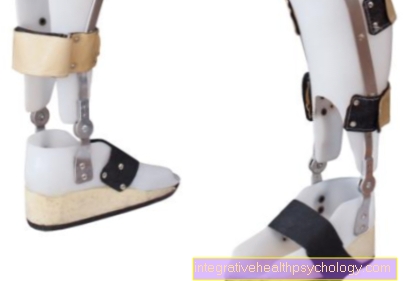amputation
Synonyms in a broader sense

Separation; Limb separation; Separation; Disarticulation; Limb removal
Latin: amputare = cut off, decrease
Definition of amputation
The term amputation describes the surgical or, in rare cases, traumatic separation of a part of the body, a limb or another appendage of the body. Such interventions are only necessary if the preservation of the corresponding part of the body is no longer possible or the life and health of the patient are irrevocably endangered.
If after a failed attempt at replantation, i.e. an attempt to replant, a limb that is not supplied with blood has to be removed again, this is called reamputation.
Epidemiology / incidence / frequency
A precise indication of the number of amputations performed in Germany is not possible due to the lack of an amputation register.
According to estimates by the German Society for Angiology, there are around 60,000 amputations per year in Germany, a relatively high number in a European comparison.
According to the Ärzte Zeitung, around 70-80% of amputations in Germany affect diabetics with peripheral arterial occlusive disease (PAOD). As a rule, these are lower leg amputations. (Leg amputation) Diabetics have a 10-15 times higher amputation risk than non-diabetics. Men are more often affected.
How can it be ensured that an amputation really has to be carried out?
Due to the diverse causes of an amputation, diagnostics must also use different means.
At the beginning of course there is a clear questioning of the patient (anamnesis), the collection of typical risk factors such as smoking or diabetes mellitus and a physical examination.
If there is a circulatory disorder, it must be examined to what extent the blood flow in the affected vessels is restricted. First of all, it must be determined whether pulses can still be felt in the affected extremity and whether adequate blood pressure can be measured. If the legs are affected, as is usually the case, functional tests can be carried out. For example, a treadmill is used to test how far the patient can go.
A reduced blood flow is made visible through a vascular representation in the X-ray image with a contrast agent (angiography) or in ultrasound (duplex sonography). Taken together, these tests will determine whether the limb can be preserved.
Read more on the topic: Doppler sonography
Imaging methods are also used for tumors or accidental (traumatic) injuries. This includes:
- the x-ray, e.g. of breaks
- computed tomography (CT)
or - a radioactive imaging procedure (scintigraphy).
A blood test is often also required.
Based on the examinations, the doctor can determine whether and where the limb needs to be removed.
Read more on the topic: Causes of an amputation
These symptoms can indicate the need for an amputation
Symptoms of circulatory disorder
Signs of a serious circulatory disorder in peripheral arterial occlusive disease (PAOD) are pain that occurs primarily during exercise, but is later also present at rest.
The affected limb is cold and pale due to the decreased blood flow. Ultimately, the tissue dies (necrosis), and in severe cases an infection develops that can spread to the body (sepsis) and must be treated.
Symptoms tumor
Malignant tumors develop in:
- the connective tissues of the extremities (sarcomas)
- the bones (osteosarcomas)
- the muscles (rhabdomyosarcomas)
- the blood vessels (angiosarcomas)
or - the cartilage (chondrosarcoma)
these must always be treated.
Due to their malignant infiltrating growth, the tumors destroy the surrounding tissue, which in advanced stages manifests itself in pain, palpable and visible thickening and functional restrictions. In order to prevent the tumor from spreading to other tissues (metastasis), the tumor must be removed quickly, but this is sometimes only possible through an amputation.
Symptoms after an accident
In the case of severe injuries from any trauma, such as large cuts, the symptoms appear as a result of the circulatory disorder, nerve damage that can lead to loss of sensation (loss of sensitivity) or paralysis, and direct painful tissue damage.
Serious bone fractures or joint damage, in which normal function cannot be restored, are also the result of trauma.
Symptoms infection
If there is an infection, the affected part of the body becomes reddened and swollen, and in some cases overheating.
If the inflammation spreads over the body via the bloodstream (sepsis = blood poisoning), fever and chills develop.
If this is not treated, symptoms of shock with a drop in blood pressure and increased heart rate can endanger the life of the patient due to circulatory failure.
Surgery complications
Complications that can arise from the operation are:
- Damage to surrounding tissues
- Bleeding
- Infections
- Wound healing disorders
and - Scarring
- Pressure damage through the prosthesis
- Nerve pain
- unnatural connections between veins and arteries (Shunts)
such as - Paralysis.
A major problem with amputation is the Phantom pain Despite the lack of the body part, pain and abnormal sensations are still felt in the arm or leg that is no longer there.
The changed statics can also damage the Spine and Joints come.
forecast
A successful healing of the operated body part is shown by:
- Good nutrition the local tissue
- Presence of arterial pulses above the amputate
- a satisfactory course (circulation) of the blood with healthy color and temperature of the skin
- The local infection and the Swelling (edema)
and - no reddening of the amputation site with hanging limbs and rapid filling of the venous vessels
such as - the lack of pain from under-supplied tissue (Ischemia) in peace
such as - painless scars.
Because through the amputation the damaged tissue has been removed, consequential damage is rare.
Has the inflammation but already distributed in the body or the tumor scattered before the amputation could take place, the patient's life often cannot be saved despite the operation.
A complete restoration of the state before the removal of a limb is of course not possible, but you can Prostheses most functions are resumed.
In addition, there is a possibility that sensations of pain, a type of nerve pain known as phantom pain, may develop in the removed limb.
Causes of an amputation
As a result, various causes can make it necessary to carry out an amputation. These include, for example, serious injuries in which blood vessels and nerves have been severed or the tissue has been severely damaged so that the body part can no longer heal.
Most often, however, a severe circulatory disorder ultimately means that parts of the body that are no longer adequately supplied with blood, such as toes, have to be amputated. About this arterial occlusive disease or also Intermittent claudication called, it can come from a variety of risk factors.
Smoking, obesity and untreated high blood pressure are primarily responsible for this. Poorly controlled diabetes (diabetes) to circulatory disorders, especially of the feet, so that diabetics are about 15 to 20 times more likely to have an amputation.
In addition to this usually slowly increasing deterioration in blood flow, a sudden occlusion of a blood vessel in the arms or legs can, in the worst case, require an amputation. This can happen, for example, with certain cardiac arrhythmias that lead to the formation of a blood clot that clogs the blood vessel.
Other vascular diseases such as the veins can ultimately make an amputation necessary.
In rare cases, a cancer of the bones, for example, is the reason why a part of the body has to be amputated.
Usually an amputation is only possible as the last remaining measure carried out when there is no longer any prospect of preserving the affected body part.
Read more about this under: Causes of an amputation
Concomitant symptoms
Accompanying symptoms that can precede an amputation are often poorly or not at all healing wounds on arms or legs and persistent pain. If these occur not only during exercise, but already at rest, an impending amputation can sometimes no longer be avoided.
You might also be interested in: Wound healing disorder
A severe infection that ultimately leads to the need for an amputation is often accompanied by symptoms such as fever, chills, and fatigue.
After an amputation With good wound healing, apart from the loss of function due to the amputated body part, there are no accompanying symptoms. However, since amputation is required in most cases in patients with a poor immune system (e.g. diabetics) and insufficient blood flow, wound healing disorders are not uncommon, especially with larger amputations. In particular, this can lead to pain in the area of the residual limb. In some cases, patients also complain of so-called phantom pain as the disease progresses. Pain or other unpleasant perceptions (for example tingling) are perceived from the part of the body that is actually amputated.
You might also be interested in: Pain after surgery
Amputation of the thigh
Amputations from the thigh down are necessary either after serious accidents or when there is a pronounced circulatory disorder. In the latter case, an amputation of the thigh is only carried out if the blood flow to the lower-lying parts of the leg is no longer sufficient and cannot be restored by medical measures. Often parts of the foot or leg have already been amputated beforehand.
Less common conditions that may require amputation of the thigh include severe bone inflammation and some cases of cancer of the bone. During amputation of the thigh, the bone and the surrounding soft tissue are severed as close as possible to the knee so that the greatest possible mobility of the thigh stump is maintained. However, if the thigh is also poorly supplied with blood, a higher amputation may be necessary.
Read also: Amputation heights
In many cases, a prosthesis can be individually adapted in the course of the process. However, this is significantly more difficult with a thigh amputation than, for example, with an amputation in the area of the lower leg. In particularly severe cases, the entire leg has to be removed from the hip joint so that no movable stump remains. In addition, phantom pain and phantom pain can occur in the course of the procedure.
Find out more at: Thigh amputation
Amputation of a toe
The amputation of a toe is most likely required as a result of a circulatory disorder in intermittent claudication or diabetes. If the toe can no longer be adequately supplied with oxygen and nutrients via the blood, it must be amputated so that it does not die and lead to inflammation.
You might also be interested in: Circulatory disorders in the feet
In the case of an amputation in the foot area, an attempt is always made to remove as little bone as possible so that the patient can still stand and walk after the removal. If only one or more toes have to be amputated, the stability is usually not significantly impaired. However, the wound must first heal in a stable manner before the foot can be fully loaded again.
The amputation of a toe is a rather small procedure that often only takes 20 minutes. The operation can be performed either under general anesthesia or with local anesthesia on the affected leg.
The separated tissue is usually examined microscopically by a pathologist. A short inpatient hospital stay is usually sufficient for the procedure. If necessary, the operation can even be carried out on an outpatient basis.
Read on below: Amputation of a toe
While the amputation of the toes is often caused by illness, the amputation of a finger is usually caused by an accident. B. when gardening or from deep cuts in the kitchen. However, in the context of circulatory disorders, the fingers and especially the fingertips are also affected, so that if the tissue there dies, an amputation of the finger is necessary.
Read on below: Amputation of a finger







.jpg)



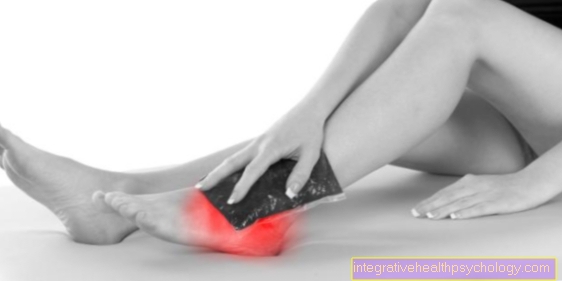



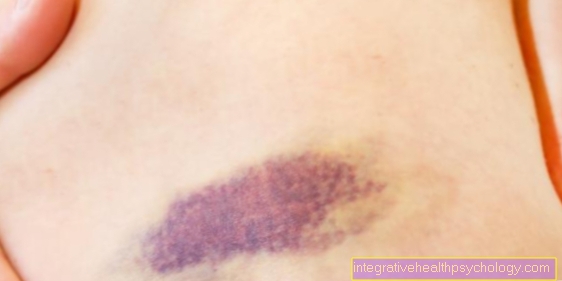
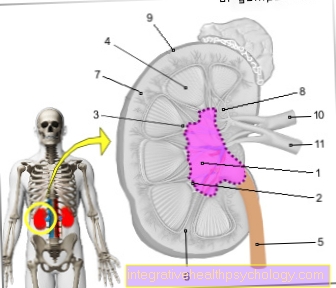
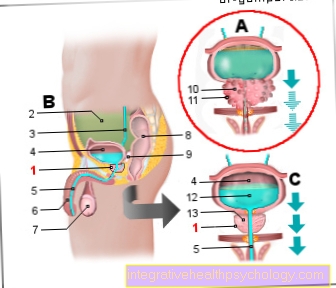



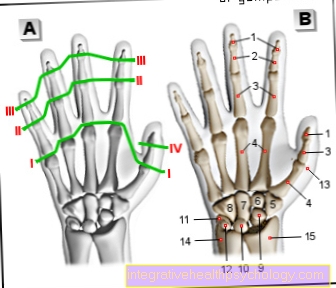
-und-lincosamine.jpg)





